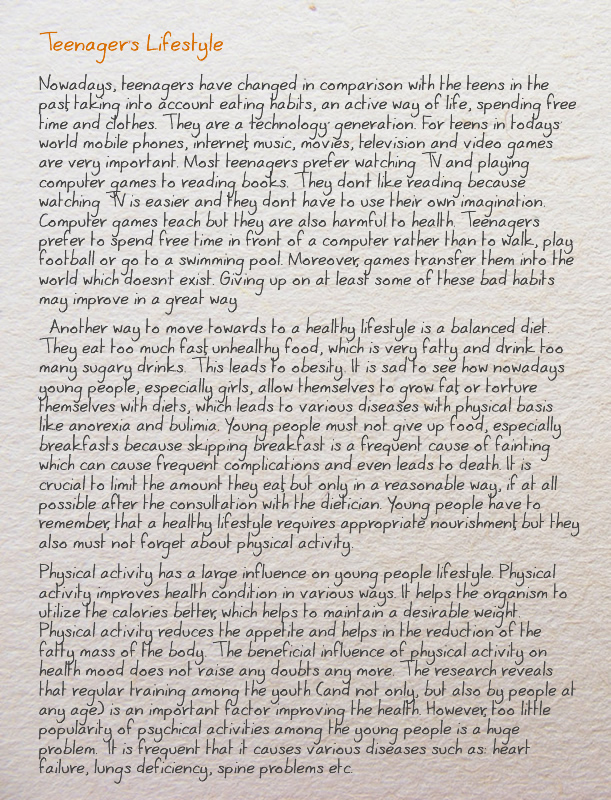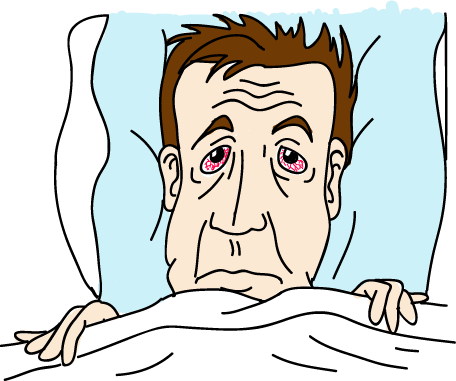Being healthy, a lifestyle that is worthwhile
In this section, you will learn to use a grammatical form called the first conditional. These sentences are used to talk about events that will probably take place in the future because of an action or event in the present.
First conditional sentences are made of two smaller sentences: a sentence in future tense with the auxiliary will and another sentence in simple present. These two sentences are joined together with the conjunction if. Read the following sentence carefully:
You will have
no problem with conditional sentences
if
you know
the simple present and future tenses.
In the following activities, you will use conditional sentences to discuss daily habits and their consequences to your health in the future.

By the end of this topic you will:
• Use the first conditional structure (if + present simple and will + the base form of the verb) within a context of healthy lifestyles and the appropriate vocabulary to show actions that have a future outcome or that occur after an event. Let’s get started!!!
Watch the following animation.
First conditional sentences:
Conditionals consists of the particle IF, a sentence in present simple and another one in future with will.
So first we’ll review the structure of simple present and then the ones for future with will. This is to be sure you remember well the rules of both.
Let’s remember some grammar points…ok?
Grammar guidelines
Click on each concept to display the contents.
Present will
We use the Simple Present to express the idea that an action is repeated or usual. The action can be a habit, a hobby, a daily event, a scheduled event or something that often happens. It can also be something a person often forgets or usually does not do.
In the structure of the affirmative, we add S to the verb on third person singular:
subject + verb + complement
I
You
We
They
get up
at 6:00 o'clock every day
He
She
It
gets up
at 6:00 o'clock every day
The Structure for the negative is:
Subject + auxiliary verb + NOT + verb + complement
I
You
We
They
do
n't
get up
at 6:00 o'clock every day
He
She
It
does
n't
get up
at 6:00 o'clock every day
The Structure for the question is:
Auxiliary verb + subject + verb + complement?
Do
I
you
we
they
get up
at 6:00 o'clock every day?
Does
he
she
it
get up
at 6:00 o'clock every day?
Future will
We use future with will for events, spontaneous decisions, predictions based on opinions, promises, requests, refusal and willingness. In first conditionals, it is the result of the condition.
The Structure for the affirmative is:
I
You
He
She
It
We
They
will
be
very happy
The Structure for the negative is:
Subject + will + NOT+ verb + complement
I
You
He
She
It
We
They
wo
n´t
get
sick
The Structure for the affirmative is:
will + subject + verb + complement?
will
I
You
He
She
It
We
They
get
sick?
Great! Review the grammar of both structures in conditionals, we are getting closer! Now you’ll get the opportunity to practice each form. The exercise consists of two activities, and each of them will give instructions to perform them. Remember this is a practice, not evaluation so you can do the exercises as many times as you need.
Now that you have practiced we can go to our matter!! But first things first:
Let’s check how we make and how to use first conditionals when we talk about lifestyles.
Hover the mouse to display the information.
The first conditional has the present simple after if, then the future simple in the other clause:
The first conditional has the present simple after if, then the future simple in the other clause:
Affirmative
If + present simple, subject + will + base form of the verb + complement
If Danny eats healthy, he will get sick.
Negative
If + present simple, subject + will + NOT + base form of the verb + complement
If Danny eats healthy, he won’t get sick.
Question
Wh + will + base form of the verb + if + subject + present simple + complement?
What will happen if you eat healthy?
The First conditional is used to talk about things which might happen in the future. Of course, we can't know what will happen in the future, but this describes possible things, which could easily come true.
• Use if + present to talk about a possible situation and will/won’t + the base form to talk about the consequence.
• The if clause can come first or second. If the if clause comes first, we usually put a comma before the next clause.
• You can also use the imperative can + base form instead of will + base form in the other clause.
Example:
At the end of the learning tasks you are taking a test just to verify how well you are using the structure. Remember! The more you practice, the more you learn and the better you communicate.
Activity 1
As previously mentioned first conditional allows expressing the result in the future of action in the present. Now you’ll have to identify the present and future actions within the first conditional.
It is time to read about a teenager’s lifestyle with lots of suggestions to get healthier!
This activity has three sections that you’ll have to completely fulfil. In each section, you will be given the corresponding instructions.

Part 2

Activity 2
In this activity, you will have to identify some tips for having a healthy lifestyle.
To do so, you’ll have to complete the two sections of the activity. You’ll get specific instructions for each of them.
Activity 3
As mentioned in the video of the previous activity, sleeping well is part of a healthful lifestyle, but sometimes our activities do not let us rest well or enough.

This activity has two sections; each of them will give you specific instructions.
By the end of this activity, you’ll have your first draft to start a healthy lifestyle.
Activity 4
As you could see on this unit, to have a healthy lifestyle, it is necessary to start doing some actions which in the future will give you results that will be reflected in your soul, body, and mind.
Now it is your turn to share some habits and benefits of a healthy life, so you’ll have to record an audio.
First, watch the video, "How to start a healthy lifestyle". In this video, a girl gives some suggestions so you can get an idea of how to do your own audio.
To record your audio do the following:
1. Before speaking, take your notes
Look for information about healthy habits and write 5 exciting aspects that will help you start creating a healthy lifestyle.
Once you've decided on the advice, you want to give, practice saying them several times. Don’t forget to include why you recommend them using first conditional.
2. Record yourself
Then, record yourself giving the tips.
Your audio has to include:
• Introduction of yourself
• Introduction to your topic
• The tips (numbered)
• A goodbye
Use your computer or your cell phone to record yourself.
Remember that it is not about reading your notes, but about reinforcing your ability to speak.
Before recording yourself, study the aspects that will help you to evaluate yourself described in the checklist. The following example will also help you to do your recording.
It is time to put your knowledge to practice! You will do two parts to complete the self-assessment.
AAs we have mentioned the first conditional is used to talk about what might happen in the future.
Choose the most appropriate option to complete the first conditional sentences.
Cambria Joy. (2013, december 31). Tips for starting a healthy lifestyle [video]. Taken from https://www.youtube.com/watch?v=0aNNYEUARAk
English page. (w.d.) Simple present [website]. Available at: https://www.englishpage.com/verbpage/simplepresent.html
Kaylee Marie. (2015, january 2). How to start a healthy lifestyle [video]. Taken from https://www.youtube.com/watch?v=LQBGhF9Zin4
Perfect English Grammar. (w.d.) Simple future [website]. Available at: https://www.perfect-english-grammar.com/simple-future.html
Gagilas, P. (2008). Healthy breakfast [photo]. Taken from https://bit.ly/2m6KNxy. Consulted on January 18, 2017.
Hegyessy (2012). Baked Salmon, spinach and sunny side egg [photo]. Taken from https://bit.ly/2kGpW7f. Consulted on January 18, 2017.
Lehmann, A. (2014). Gym [photo]. Taken from https://bit.ly/2l2secH. Consulted on January 18, 2017.
Oilchel (2015). Sleeping [photo]. Taken from https://bit.ly/2m2FMcj. Consulted on January 18, 2017.
Sánchez, A. (2014). Running [photo]. Taken from https://bit.ly/2m6JDlt. Consulted on January 18, 2017.
SeattleYogaNews.com (2014). Yoga Seattle [photo]. Taken from https://bit.ly/2lAV1bs. Consulted on January 18, 2017.
With wind (2014). IMG_1607 [photo]. Taken from https://bit.ly/2lgNRZn. Consulted on January 18, 2017.
Ziai, A. (2013). Healthy [photo]. Taken from https://bit.ly/2mgZ1Lr. Consulted on January 18, 2017.
English page. (w.d.) [website]. Available at: https://www.englishpage.com